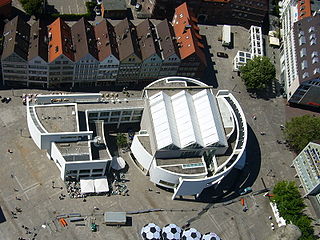
Meister Hartmann was a German sculptor active from c. 1417 to 1428, and the earliest exponent of the Ulm school.

Meister Hartmann was a German sculptor active from c. 1417 to 1428, and the earliest exponent of the Ulm school.

Ulm is a city in the German state of Baden-Württemberg, situated on the river Danube on the border with Bavaria. The city, whose population is estimated at more than 126,000 (2018), forms an urban district of its own and is the administrative seat of the Alb-Donau district.

Max Bill was a Swiss architect, artist, painter, typeface designer, industrial designer and graphic designer.

SSV Ulm 1846 is a German football club from Ulm, Baden-Württemberg. The modern-day football department, officially playing as SSV Ulm 1846 Fussball, was formed on 9 March 2009 when the department separated from SSV Ulm 1846.
The Virgin Annunciate is a painting by the Italian Renaissance artist Antonello da Messina, housed in the Palazzo Abatellis, Palermo, region of Sicily, Italy. Probably painted in Sicily in 1476, it shows Mary interrupted at her reading by the Angel of the Annunciation. It is painted in oil on panel, a technique introduced to Italy by its artist, who had learned it from North European artists such as Petrus Christus - by thus abandoning tempera technique he was able to produce the finely-detailed works typical of him.

The Ulm School of Design was a college of design based in Ulm, Germany. It was founded in 1953 by Inge Aicher-Scholl, Otl Aicher and Max Bill, the latter being first rector of the school and a former student at the Bauhaus. The HfG quickly gained international recognition by emphasizing the holistic, multidisciplinary context of design beyond the Bauhaus approach of integrating art, craft and technology. The subjects of sociology, psychology, politics, economics, philosophy and systems-thinking were integrated with aesthetics and technology. During HfG operations from 1953–1968, progressive approaches to the design process were implemented within the departments of Product Design, Visual Communication, Industrialized Building, Information and Filmmaking.

Gregor Erhart was a German sculptor who was born at Ulm, the son of sculptor Michel Erhart. Gregor spent his working career at Augsburg, where he was made master in 1496, and where he died.

The Stadthaus Ulm is in the centre of Ulm (Germany), located on the Münsterplatz. Primarily, the building is used to present exhibitions of photography, modern and contemporary art. A lecture hall is used for a variety of events, activities and workshops, including a festival of modern music. It houses the city's Tourist information centre and other public services on the ground floor. A permanent exhibition of the archaeology and history of the Münsterplatz is located on the lower level.

Michel Erhart was a German late Gothic sculptor who lived and worked in Ulm.

Jörg Syrlin the Elder was a German sculptor who is considered part of the Ulm school. After his death his son Jörg Syrlin the Younger took over command of his workshop. His best known works are the carvings for the choir stalls of the Ulm Minster.

Jörg Syrlin the Younger (c.1455–1521) was a German sculptor. He was born in Ulm, the son of Jörg Syrlin the Elder and became a member of the Ulm school.

Jörg Stocker was a German painter.

Niklaus Weckmann was a German sculptor.

Daniel Mauch was a late Gothic German sculptor. He was born in Ulm and died in Liège.

Juno and Argus is a 1610 painting by Peter Paul Rubens, showing Juno and Argus. It is now in the Wallraf-Richartz Museum in Cologne.

The term Cologne School of Painting was first applied in the 19th century to describe old German paintings generally. It subsequently came to refer more specifically to painters who had their workshops in medieval Cologne and the lower-Rhine region from about 1300 to 1550.

Karlheinz Bux is a German artist concentrating on drawing and sculpture works.
Ernst Gustav Zipperer was a German painter and printmaker.

Gebhard Fugel was a German painter specializing in Christian themes. He is best known for his work as the leading artist of the Crucifixion Panorama in Altötting.

The Museum Ulm, founded in 1924, is a museum for art, archeology, urban and cultural history in Ulm, Germany.

Barbara Kluntz was a German composer and music teacher. On all of her book titles, she calls herself "Barbara Kluntz the Noble Music Art Lover", in order to explicitly emphasize her position: She did not consider herself a professional musician.